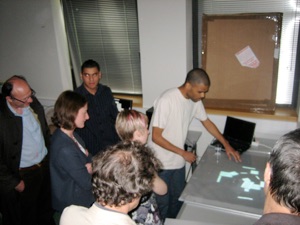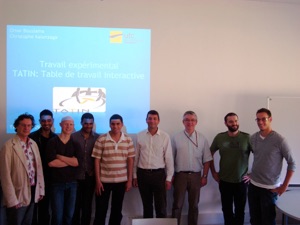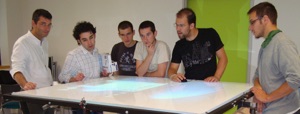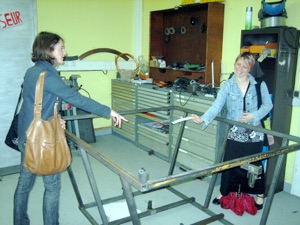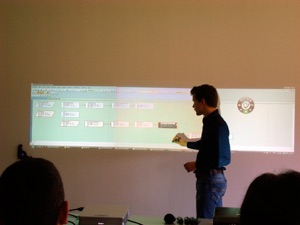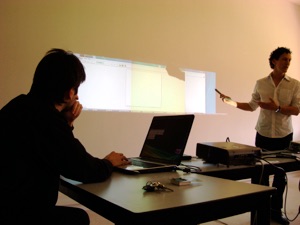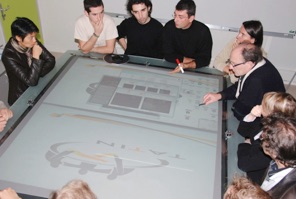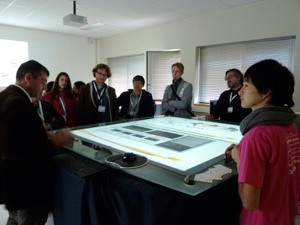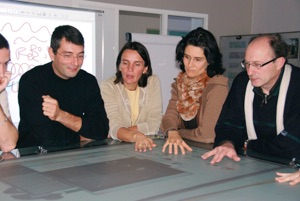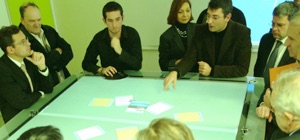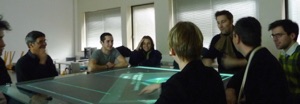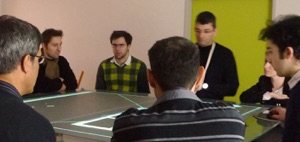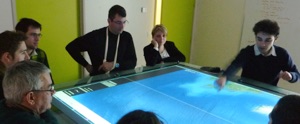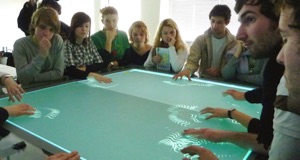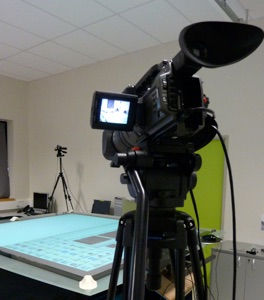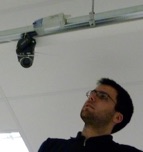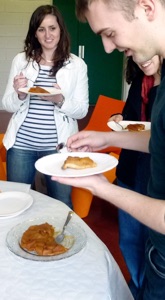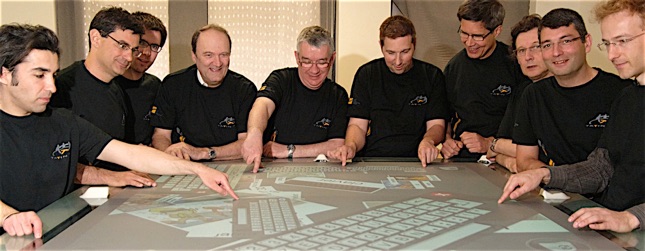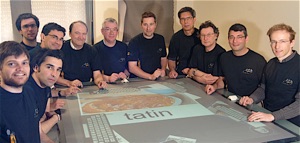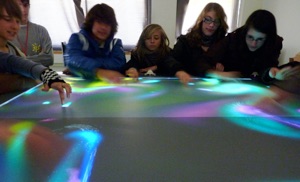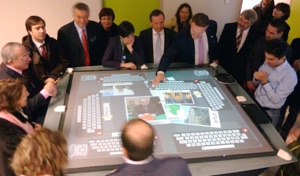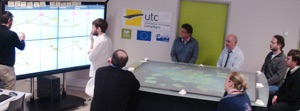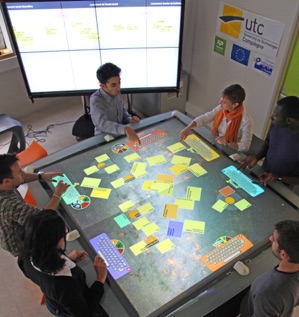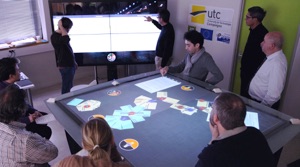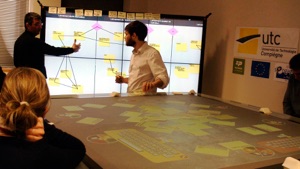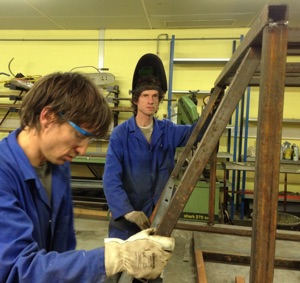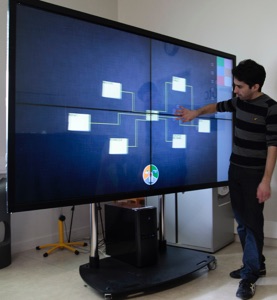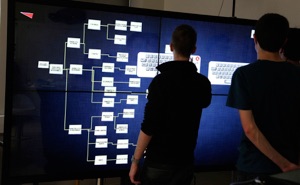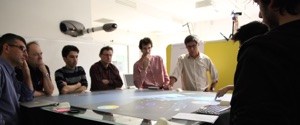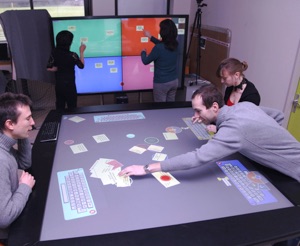At the beginning...
Since the beginning, our motivation has been to improve creativity and problem solving for small groups.
We’ve been dreaming of a new kind of system that would increase individual and collective cognitive abilities.
We wanted our system to change the way people work during preliminary design phase of engineering projects. Generally, the meetings during this phase of work involve a small team and a manger, and require clear communication, fluid collaboration, and constant engagement in order to be productive and successful. This is why teams leave their computers behind, book a conference room for a day, and use whiteboard, tables, walls, and plenty of pen and paper or Post-its to sketch and express ideas.
The drawings, charts and graphs that are created during these sessions are extremely valuable. They are artifacts, which capture the creative approach of the team. But they are difficult to render into a digitally exploitable format, unless one teammate stays behind, writing notes, taking pictures, making photocopies, etc.
We cannot design a system that uses traditional PCs because that would obstruct communication and collaboration in the meeting room. Instead, we build new devices with better form factors: we design interactive tables, whiteboards, and walls, that teams can use together as a shared interface, through multi-touch and vocal interaction.
This is a new kind of interactive computing environment for collaboration.
FIRST INTERACTIVE BOARD
When the UTC Innovation Centre started the Saturn Platform in 2006, we decided to try interactive white board technology to enhance collaborative session.
We soon realize that this was not practical for several reasons: mono-user interaction, low resolution, projected shadors, ergonomic problems, etc.
INTERACTIVE BOARD PROTOTYPES
So we tried several alternatives. To overcome resolution issues, we adapted the interactive board to be used with two and three video-projector. Matthieu Avignon, Michaël Mangili-Vincent and Mathias Taltavull participated in the implementation and test of these prototypes in 2008.
But the shadows from the projectors, and software that was designed for only one user created problems for collaboration.
EXPERIMENTAL PROTOTYPE: TABLE v0
A first prototype of a small table (V0) was design to test the multi-touch technology and facilitate discussion around an initial scenario. In 2008, Omar Bouslama and Christophe Kalenzaga were involved in the design of the first table and it application.
FIRST TATIN RESEARCH PROJECT
In January 2009, we launch the first TATIN research project.
At this stage we made several radical design choices:
- We decided to shift from vertical to horizontal surface because scientific publications demonstrate that horizontal surface was more efficient for creativity in brainstorming session.
- We decided to build our own interactive table, as nothing was available on the market at this time with the required characteristics.
- We decided to develop our middle and software from scratch. After a few trials to adapt existing software, we realize that it was far more difficult to adapt mono-user software, designed for a user with a mouse, a keyboard and a screen than to develop a new type of app allowing real multi-touch & multi-user functions
- We choose apply an enactive approach, which is well known at the UTC, which involves co-design usage scenario together with potential users, computer software specialists and hardware engineers.
FIRST PROTOTYPE: TABLE v1
At the same time, we where designing a full-blown prototype (table V1) with resolution, precision and latency characteristics compatible with professional applications. The goal was to go beyond the classic “photo sharing” application for multi-touch surfaces, and to actually create applications for performing useful collaborative work in preliminary design sessions.
At this stage we, had a very interesting and constructive discussion with our colleagues form Arts&Metier ParisTech, Céline Mougenot and Stéphanie Buisine.
Scenario DEFINITION
25th february 2009
CAUSAL ANALYSIS
Spring 2009: An app to support causal analysis is developed by two students Mohamed Yehdhih & Adrien Tillier.
DESIGN VALIDATION
16th april 2009
TABLE INSTALLATION
30th june 2009: First trial in big format!
PREPARATION OF THE FIRST EXPERIMENTS
February 2009: David Burgaud is recruited to help preparing the first experiment based on brainstorming sessions.
CONFERE, MaRRakech
3rd july 2009
TABLE DESIGN IMPROVEMENT
September 2009: Fabien Chateau is recruited as a student in training to help improve the table design. An new prototype, table V1.1 is tested.
DPPI 2009
First official demo in Compiègne
13-16 october 2009
Collegium CNRS-UTC
Collegium CNRS-UTC presentation, 26th november 2009
TouchCamp in Compiègne
10th december 2009
MARKETING STUDY
Autumn 2009: A group of students Fabrizio Bertone, Andréa Guerra, Thibaud Lehmann & Sébastien Monin carried out a marketing study.
UTSEUS in Compiègne
13th, January 2010
FIRST SPIN OFF
2010 Based on the research work, two OSEO prise are won. Fabien Chateau, a student who was recruited to help designing the table, decided to launch a start--up firstly called Intact, which will later become Virtual Sens.
Visit Prefet de l'Oise
20th january 2010
First scientific experimentations
In february 2010, Guillaume Lehoux is recruited to help preparing and implementing the first scientific experiment on the table. Experiment on brainstorming sessions are carried out from april to mai 2010
COURTRAI STUDENTS
8 march 2010
Adrien MONDOT - XYZT - EJL
5 mai 2010
Fête de la science
21 au 24 october 2010
Gesture camp à Lille
10 & 11 june 2010
SOFTWARE ARCHITECTURE AND InTERACTIVE GESTURE
Spring 2010: Two groups of students (Vincent Castellano, Guillaume Wrzyszcz, Thibaud Vandesteene, Jian XU and Andrea Guerra, Fabrizio Bertone, Philibert Maniez, Valérian Courtillon) present their soft development. Sorlier Claire & Laville Jeremy proposed a library of gestures on the table after conducting a ergonomic study.
NTU Singapore
15 june 2010
CONFERE Sousse
Tunisia
2 july 2010
LINKOPING
20 september 2010
TATIN-PIC RESEARCH
PROJECT LAUNCH
5 october 2010. Alistair Jones join the team as a PhD student.
Fête de la science
21 au 24 october 2010
IDMME Bordeaux
21 au 22 october 2010
Presentation REGION PICARDY
A. Delahaye et Marc André Fliniaux 29 october 2010
Dassault Aviation PROJECT LAUNCH
17 november 2010
Semaine de la recherche et de l'innovation
23 november 2010
Visit G-Scop Grenoble
12 janvier 2011
Presentation ECIU
8 february 2011
NEW SOFT ARCHITECTURE
February 2011: Based on identified scenarios, ontology definition and following multiple discussions a new agent based architecture is defined.
Presentation AERES
11 march 2011
KLONK CONCEPT
March 2011: Introduction of the KLONK concept to replace the ‘post-it’ concept (Kind of Large Object with New Knowledge...)
Groupe GTI / European Concept
11 may 2011
Ecole POMPIDOU
19 may 2011
EIAH CONFERENCE in mons, belgium
25-27 mai 2011
INTEROPERABILITY
April 2011: Interoperability principle between tools developed and devices are define.
CSCWD conference in LausanNE
8-10 june 2011
ICED CONFERENCE in Copenhagen, Denmark
15-18 august 2011
Soft development
July - August 2011: Aymeric PELLE is recruited to develop the soft during summer hollidays
SCENARIOS IMPROVEMENT
Autumn 2011: Based on the previous work, existing scenarios are improved. A group of student is particularly involved in this work: Pierre Cuni, Maimouna Sene, Emmanuel Achour and Aurélien Meunier.
PhD student
April 2012: Andrea Guerra, who had worked on the development of piece of software, is now recruited as PhD student to study the impact of CSCWD system on preliminary design strategies.
SECOND SPIN OFF
April 2012. Mathieu Lacome is recruited to define the business model of the second spin off. Atman Kendira takes the lead of SOFTHINK.
TOOLS IMPROVEMENT
2012: Esteban Pasquier.
SOFTHINK
May 2012, The spin off win an OSEO Emergence prise.
DCIS-AVI CONFERENCE IN CAPRI, ITALY
21-25 may 2012
CSCWD conference in whuan, china
23-25 may 2012.
ICCI CC Conference in kyoto, JAPAN
22-23 august 2012
Scientific experiements
October 2012: Project planning activities using both the table and the board are carried out.
SEMAINE DE LA RECHERCHE & DE L’INNOVATION, PICARDY REGION
27 to 30 november 2012 Amiens
NEW DESIGN for the table
January 2013: Based on the return on experiment, a new table design associated with a board are proposed.
DEVELOPER
March 2013: Gaël Charpentier is recruited to improve and document the code.
SCIENTIFIC EXPERIMENT
March 2013: New series of experiments: complexe design activities are carried out, involving value analysis, problem solving, causal analysis.
INOVACT IN REIMS, FRANCE
22 to 25 march 2013: Softhink participate to this event
CHI CONFERENCE IN PARIS, FRANCE
27 april to 2 may 2013
NEW: TABLE V2
May 2013: A new version of the table is tested.
WIDGETS
Spring 2013: Arnaud Schwartz, Patrick Yang, Joanne Antonetti, Bruno Medeiros develop some widgets such as file chooser to complement the soft.
ICED CONFERENCE in seoul, Korea
19-22 august 2013
SEMAINE DE LA RECHERCHE & de l’innovation
26 to 29 november 2013 in Creil, France.
SCIENTIFIC EXPERIMENTS
Autumn 2013: Experiments are carried out for three types of activities: project management, design management and data mining / business intelligence.
INNOVATION CENTER
March 2014: The TATIN project move to the brand new UTC innovation center.
mardi DE l’economie
1st april 2014: Presentation of TATIN project.
FOIRE A L’innovation
3 april 2014: Softhink present the TATIN environnement.
PRINTEMPS DU NUMERIQUE
6 may 2014: Softhink present the TATIN environnement.
HALLE NUMERIQUE PROJECT
1 january 2015: Start of a new project !
The UTC’s innovation centre will be equiped with full collaborative space composed of 5 interconnected working environnement (tactile table & board). This will allow 5 groups of 6 persons to work simultaneously.
CONCOURS CONNEXION
If you want more detail about the Halle Numérique see:



